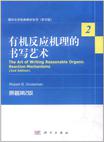有机反应机理的书写艺术
出版时间:2012-1 出版社:科学出版社 作者:格罗斯曼 页数:355
Tag标签:无
内容概要
每一个满怀抱负的有机化学家都尝试写出合理的有机反应机理,然而市面上的有关机理正确书写的书籍却寥寥无几。《有机反应机理的书写艺术(原著第2版)》将帮助学生和科研人员提高这一重要技能。《有机反应机理的书写艺术(原著第2版)》的突出特点体现在:正确的书写形式,“常见错误提示”,配以大量的难度适宜的问题。其另一个特色是包含过渡金属参与或催化的反应章节。相对新的课题,例如,烯烃复分解反应、芳香环化反应等在《有机反应机理的书写艺术(原著第2版)》中均有所涉及。
全新修订的第2版精彩呈现:更新的反应机理,芳香性的讨论,酸性,立体化学的拓展,重新组织了自由基反应和金属参与或催化的反应等内容,增加了新的问题。
作者简介
作者:(美国)格罗斯曼(Robert B.Grossman)
书籍目录
Preface to the Student
Preface to the Instructor
1 The Basics
1.1 Structure and Stability of Organic Compounds
1.1.1 Conventions of Drawing Structures;Grossman’S Rule
1.1.2 Lewis Structures;Resonance Structures
1.1.3 Molecular Shape;Hybridization
1.1.4 Aromaticity
1.2 BrCnsted Acidity and Basicity
1.2.1 PK Values
1.2.2 Tautomerism
1.3 Kinetics and Thermodynamics
1.4 Getting Started in Drawing a Mechanism
1.5 Classes of Overall Transformations
1.6 Classes of Mechanisms
1.6.1 Polar Mechanisms
1.6.2 Free.Radical Mechanisms
1.6.3 Pericyclic Mechanisms
1.6.4 Transition-Metal-Catalyzed and-Mediated Mechanisms
1.7 Summary
Problems
2 Polar Reactions under Basic Conditions
2.1 Substitution and Elimination at C(sp3)一X Bonds.Part I
2.1.1 Substitution by the SN2 Mechanism
2.1.2 Elimination by the E2 and Elcb Mechanisms
2.1.3 Predicting Substitution VS.Elimination
2.2 Addition of Nucleophiles to Electrophilic仃Bonds
2.2.1 Addition to Carbonyl Compounds
2.2.2 Conjugate Addition;The Michael Reaction
2.3 Substitution at C(sp2)一X Bouds
2.3.1 Substitution at Carbonyl C
2.3.2 Substitution at Alkenyl and Aryl C
2.3.3 Metal Insertion;Halogen-Metal Exchange
2.4 Substitution and Elimination at C(sp3)-X Bonds,Part II
2.4.1 Substitution by the SRNl Mechanism
2.4.2 Substitution by the Elimination-Addition Mechanism
2.4.3 Substitution by the One-Electron Transfer Mechanism
2.4.4 Metal Insertion;Halogen一Metal Exchange
2.4.5 Ol-Elimination;Generation and Reactions of Carbenes
2.5 Base-Promoted Rearrangements
2.5.1 Migration from C to C
2.5.2 Migration from C to O or N
2.5.3 Migration from B to C or O
2.6 Two Multistep Reactions
2.6.1 The Swem Oxidation
2.6.2 The Mitsunobu Reaction
2.7 Summary
Problems
3 Polar Reactions Under Acidic Conditions
3.1 Carbocations
3.1.1 CarbOCation Stability
3.1.2 Carbocation Generation;The Role of Protonation
3.1.3 Typical Reactions of Carbocations;Rearrangements
3.2 Substitution and 一Elimination Reactions at C(sp3)一X
3.2.1 Substitution by the SNl and SN2 Mechanisms
3.2.2 Elimination by the E1 Mechanism
3.2.3 Predicting Substitution VS.Elimination
3.3 Electrophilic Addition to Nucleophilic C=C Bonds
3.4 Substitution atNucleophilic C=C Bonds
3.4.1 Electrophilic Aromatic Substitution
3.4.2 Aromatic Substitution of Anilines via Diazonium Salts
3.4.3 Electrophilic Aliphatic Substitution
3.5 Nucleophilic Addition to and Substitution at Electrophilic
Bonds
3.5.1 Heteroatom Nucleophiles
3.5.2 Carbon Nucleophiles
3.6 Summary
Problems
4 Pericyclic Reactions
4.1 Introduction
4.1.1 Classes of Pericyclic Reactions
4.1.2 Polyene MOs
……
5 Free.Radical Reactions
6 Transition-Metal-Mediated and-Cata!vzed Reactions
7 Mixed.Mechanism Probiems
A F.nal Word
Index
章节摘录
版权页:插图:The C and N atoms in CH3'and NH4+both have formalpositive charges.but the C atom is electron-deficient,and the N atom is not.The C and B atoms in CH3 and BF3 are both electron.deficient,but neither is for-mally charged.B is electropositive and N is electronegative,but BH4一and NH4’are both stable ions.as the central atoms are electron-SHfficient.The C atoms inCH3+,CH3I,and HEC=O are all electrophilic,but only the C in CH3’is electron-deficient.The O atom in Me ,has a formal positive charge.but the C atoms are electrophilic,not For each bonding pattem.there are often several ways in which ql"and non-bonding electrons Can be distributed.These different Ways are called resonance structures.Resonance structures are alternative descriptions of a single com-pound.Each resonance structure has some contribution to the real structure of the compound,but no one resonance structure is the true picture.letters,lines,and dots are words in a language that has been developed to describe molecules,and,as in any language。sometimes one word is inadequate,and several differ-ent words must be used to give a complete picture of the structure of a mole-cule.The fact that resonance structures have to be used at all is an artifact of thelanguage used to describe chemical compounds. The true electronic picture of a compound is a weighted average of the dif-ferent resonance structures that can be drawn(resonance hybrid).
媒体关注与评论
“这是一部优秀并完美表达的作品……作者……成功地将反应活性和选择性的核,小观点视为一个有机整体详尽表述 简洁的文风,精选的实例……每一章末对要点简明的概括,使得读者很容易巩固学到的知识……这本书不失为一个小小的艺术品。” ——Jens Hartung ,Angewandte Chemie International Edition “我使用该书教授学分课程已经三年时间了,学生们一致对本书的透彻叙述和书中试题的覆盖面给予高度赞誉……正如本书的宗旨:教会学生准确写出陌生的有机反应的机理” ——Amy Howell,Synthesis
编辑推荐
《有机反应机理的书写艺术(原著第2版)》是国外化学经典教材系列(影印版)。
图书封面
图书标签Tags
无
评论、评分、阅读与下载
用户评论 (总计27条)
- 全英文的,对写机理很有帮助!
- 原版书,很清晰,对学习有机化学和提升英文水平都很有帮助
- 本书很好,尤其是内容纯英文(尽管封面是中文的),避免了翻译版经常存在的翻译错误,吾很喜欢。此外,内容充实而基础,值得一观。
- 很满意,生动形象,易于理解。
- 书很好看,知识量丰富,英文原版读起来很赞
- 给孩子买的竞赛书,非常好!
- 书的(印刷)质量很好,没有破损
- 全英文的,很好的学习机理的书
- 内容我看不懂,不过儿子收到以后就看起来。应该是好书吧。
- 这本书对我帮助真得非常大
- 很不错!适合提高用。
- 孩子的竞赛用书,很喜欢
- 这是很棒的一本书,会好好读的。
- 其实开始学有机的时候就可以读这本书 现在都快研究生了 才开始研读此书 悲剧 是一本很有用的书
- 作者是我见过的最好的教师之一,讲课很清晰,虽然他的学术一般。我原先有第一版,这第二版改进了不少,增加了不少内容,对最新的金属催化的进展也有不少涉及,而且很有针对性。我很推荐给研究生看。不过价格上有点小贵,印刷一般。如果价格可以便宜20%的话,学生会买科学出版社的,现在很多人还是会为省20块钱去复印。这个建议应该转给科学出版社,有时候市场很重要,了解市场应该去高校研究所,而不是坐在办公室拿一支铅笔画画算算就有结论的。总体评价:推荐!
- 这是我渴望已久的一本书。虽说有了电子版,但终究,纸版就是纸版。对于外文书,国内能出影印版是最好不过的事情!原版太太太太贵,而国人的翻译水平又很不敢恭维!当然了,除此之外,希望对于国外的新著作,国内出版影印版能够尽量尽量的早一点!
- 我正在翻译,欢迎加入。
- 书质量不错 适合学习高中化学竞赛的同学使用,
- 书很好,儿子挺喜欢,评论晚了。
- 不错的一本书,如果有中译本的就好了。
- 难得的好书。讲解清楚,调理明晰。
- 内容还行,买回来后感觉不太符合想象,不太用的上
- 国内这类题目的书很少见,值得拥有。
- 很喜欢 。没看内容,厚度刚好,唯一缺点就是比较贵,要是印刷或纸张更好些,或是便宜点就好了
- 不建议在卓越买,真是煞风景
- 很不错的一本书,通过该书可以加深对有机合成反应的理解。
- 不错的书。很适合学习机理,就是我的外文还要提高啊
推荐图书
- 畜牧兽医新技术研究与应用
- 旅游市场营销
- 护理专业教学法
- 护理专业教师教学能力标准.培训方案和培训质量评价指标体系
- 临床常见疾病护理及进展
- 护理理论与案例分析
- 电气运行与控制专业教学法
- 电气运行与控制专业教师教学能力标准.培训方案和培训质量评价指标体系
- 大学物理实验
- 数学分析(下册)
- 数理统计
- 高等数学(下)
- 大学数学线性代数
- 会计报表分析
- 理论力学教程
- 数学练习册-基础模块-下册
- 数字电子技术及应用
- 电路基础及应用
- 线性代数
- 统计学概论习题集-第四版
- 医学形态学实验教程
- 管理信息系统应用与开发
- 中国税制
- 固体物理学习题解答/高等学校理工类课程学习辅导丛书
- 全国硕士研究生入学统一考试高等数学辅导讲义
